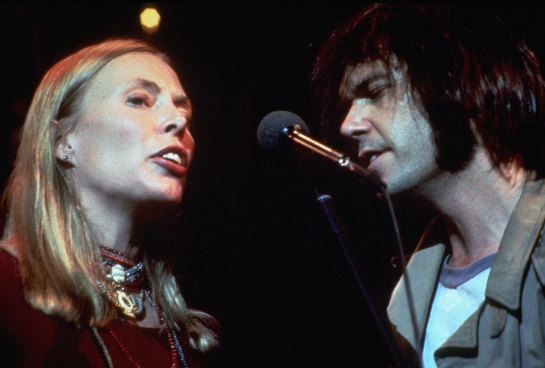By Nathan Smith
BIOGRAPHY
Travelling: On the Path of Joni Mitchell
Ann Powers
HarperCollins, $34.99
Travelling is not a typical Joni Mitchell biography, of which there are countless. Ann Powers, longstanding music critic of National Public Radio and The Los Angeles Times, freely admits she was sceptical when asked to tackle a subject so mythologised in the American songbook. It was approaching Mitchell – a figure with an impenetrable “edifice of fame” – first as critic and second as biographer that enabled her to unlock a more in-depth understanding of an already over-examined life.

Ann Powers says Joni Mitchell was already a talented musician when she contracted polio as a child.Credit: Genaro Molina
The resulting project maps a series of “journeys” – both musically and literally – Mitchell has taken in her career. It also arrives at an opportune moment when the singer and her sound return to the spotlight. After suffering a brain aneurysm in 2015, the 80-year-old retreated from public view but has recently resurfaced with a series of moving performances, including at this year’s Grammy Awards.
From the outset, Powers maintains a deliberate distance from her subject, admitting that she had an opportunity to interview Mitchell but abandoned the idea. A music critic, she says, must resist the seductive pull of an artist’s magnetism and any enticements of intimacy. This admission serves as an early indicator of Powers’ refusal to be beguiled by the Mitchell myth – including by Mitchell herself.
Born in the Canadian prairies, the singer-songwriter contracted polio at an early age and lost strength in her left hand. The illness forced Mitchell to adopt unique fingerpickings on the guitar, a technique that would later foster unusual arrangements. While previous biographers have often regarded surviving polio as the impetus for her artistic life, Powers doesn’t agree: Mitchell was already a deeply talented musician before suffering the disease, Powers writes.
Wanderlust was Mitchell’s driving force and meant the aspiring singer moved from Toronto to Detroit to New York. While transient, she began mining her interior life in her lyrics, alongside distinctive open tunings, a musical pairing that soon captivated early listeners. Men began orbiting Mitchell’s world at these pitstops – from Graham Nash to James Taylor – some of whom are eager today to “claim their spots on her map”, as Powers learns from her interviews.

Joni Mitchell and Neil Young perform with The Band in 1976, captured in the film The Last Waltz.
The biographical detail can sometimes be light, but Travelling doesn’t hold back in correcting the historical record, including on narratives spun by Mitchell herself. The artist has been quoted as saying few women played an influential role in her early music, but Powers highlights how other contemporary folk artists, such as Judy Collins and Joan Baez, undoubtedly shaped Mitchell’s turn. Nevertheless, male artists such as Bob Dylan and Leonard Cohen are the “signposts” Mitchell asks us to remember.
Whatever her influences, the singer’s music “elevate[d] the art of self-exposure” while reckoning with melancholia and disillusionment, most famously on 1971’s Blue. Songs such as This Flight Tonight and River telegraph themes of deprivation and loneliness. The lyrics unspool across the album and allow listeners to connect with her pained emotions.

Powers’ portrait of Mitchell is clear-eyed and beyond hagiography.
Powers is generous in her assessment of records such as Blue and Clouds, acknowledging their extraordinary openness and “enquiry into personal storytelling itself”. The magic around Mitchell’s vulnerability writing Blue – an experience she famously described as being as defenceless as “a cellophane wrapper on a pack of cigarettes” – is nevertheless treated with some distrust, as Powers recounts how the album was actually one long and considered creation.
While Mitchell did illustrate what it meant to be melancholic as a woman through popular music, Powers notes that Mitchell’s place within second-wave feminism remains uneasy.
The singer took pains to never universalise the experiences of her songs for all women, “ma[king] sure to say that her songs really represented only her own emotions and experiences”. Powers also doesn’t want Mitchell’s past insensitivities (such as doing blackface) to be entirely forgotten when weighing up her legacy, and handles these transgressions judiciously.
Powers also gives critical attention to several overlooked records, including Dog Eat Dog (1985) and Chalk Mark in a Rain Storm (1988), unexpected musical journeys taken with husband and collaborator Larry Klein. To Powers, her 1980s and early ’90s albums represent a major shift in the singer’s artistic life, one now firmly outward-facing. As Mitchell’s emotional life was strengthened by Klein and her creativity newly aided by painting, the songwriter’s interest in experimentation and social issues wove through her music, all as the singer used her inner world to think deeper about the outside one.

Mitchell performs at the Grammy Awards in February.Credit: Invision
With awe and incredulity, Powers offers a dazzling and discerning appraisal of a singer whose words and chords changed modern music. Travelling reveals Mitchell’s through lines and fault lines. It stresses her searching and unsettled spirit, one that propelled her to remarkable vantage points for artistic creativity and inner spaces for greater self-understanding – that are all captured in her remarkable music.
“Only a few artists … were able to create a space where they could simply commune with themselves,” Powers writes. “Joni’s music showed how that space existed within herself, and then bore it onward with her.” The clear-eyed portrait drawn here is beyond hagiography, instead critically dismantling some of the Mitchell legend while never losing sight of the incomparable artist who changed the songbook forever.
The Booklist is a weekly newsletter for book lovers from books editor Jason Steger. Get it delivered every Friday.